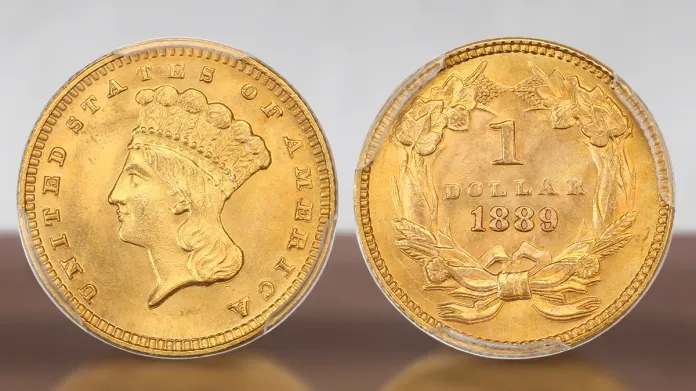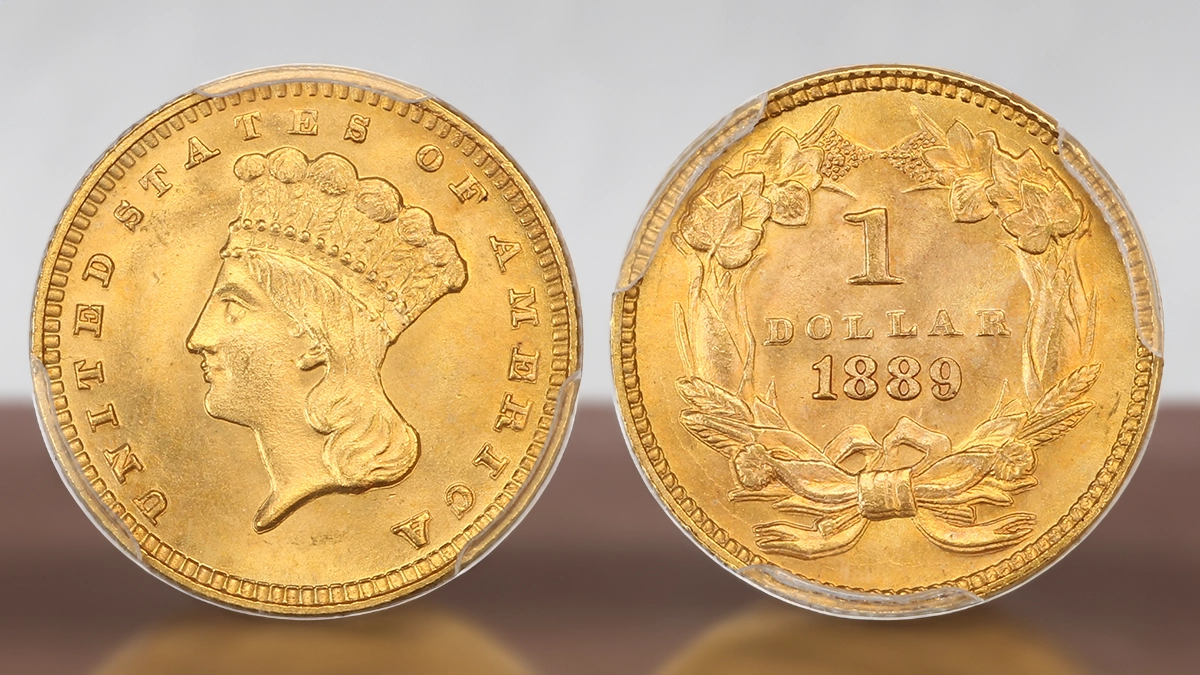
By Charles Morgan and Hubert Walker for CoinWeek Notes …..
The circulating Gold Dollar took its final bow in 1889 with the production of 28,950 coins at the Philadelphia Mint. This total is in the upper half of annual emissions for the Type 3 design, which entered production in 1856. Plentiful in Gem Uncirculated, the coin was hoarded due to its discontinuation.
As for why the Gold Dollar ceased to be, we note that the United States Assay Commission met on February 13, and, after conducting the annual assay, wrote a report proposing that Congress introduce legislation to eliminate the Gold Dollar, Three-Dollar Gold coin, and Three-Cent Nickel, citing their lack of utility in circulation and the ongoing speculation in these low-mintage issues.
* * *
1889 Gold Dollar Market Data and Noteworthy Specimens
The PCGS MS68 population for the 1889 Gold Dollar has increased from six with none finer at the beginning of 2018, to 10 with none finer in May 2019, to 14 with one finer as of November 1, 2024. The sole PCGS MS68+ coin graded was upgraded from NGC MS68.
Top Population: PCGS MS68+ (1, 11/2024), NGC MS68+ (1, 11/2024), and CAC MS68 (4:0 stickered:graded, 11/2024).
- PCGS MS68+ #32601847: As NGC MS68 #3603614-002. Heritage Auctions, December 5, 2013, Lot 3789 – $7,637.50. As PCGS MS68+ #32601847. Crossed to PCGS, where the coin upgraded by one-half point.. First MS68+ graded. Copper spots at 12 o’clock, and 1 o’clock. On the reverse, diagonal spot above D of DOLLAR. Diagonal spot bellow ribbon. Circular die crack along the periphery.
- PCGS MS68 #25218169: Stack’s Bowers, March 2015, Lot 7331 – $8,518.75; Heritage Auctions, January 31, 2019, Lot 3772 – $6,600; Heritage Auctions, June 6, 2019, Lot 3189 – $6,614.40; Heritage Auctions, November 17, 2023, Lot 3641 – $6,900. Discolorations near copper spots below UN and T of UNITED. Planchet void between T and E of STATES. On the reverse, there are die clash images visible inside the wreath. Two contact marks on the right side of the space between the two descending ribbons. Circular die crack along the periphery.
- PCGS MS68 #41713014: Heritage Auctions, November 16, 2023, Lot 3118 – $8,400. On the reverse, there are two tiny ticks above 1. Diagonal hairline scratch above O. Tick below D.
- NGC MS68 #447908-008: Heritage Auctions, February 9, 2023, Lot 3226 – $7,200. Carbon spot at neck.
- PCGS MS68 CAC #25332847: “The Bender Family Collection, Part I,” Heritage Auctions, August 24, 2022, Lot 3855 – $10,500. Bender Collection on insert.
- PCGS MS68 #42813617: Heritage Auctions, December 16, 2021, Lot 3169 – $6,025. Large carbon spot in the left obverse field below T. On the reverse, carbon spot on the upper left leaf. Another one at 7 o’clock.
- NGC MS68 #6060389-002: Heritage Auctions, July 14, 2021, Lot 3343 – $6,300. Tick the left obverse field below I. On the reverse, some chuff to the right of 1 and a tick below 1.
- PCGS MS68 #40323376: David Akers. As PCGS MS67+ CAC #25539972. “The Duckor Family Collection of Gold Dollars,” Heritage Auctions, August 2015, Lot 4290. As PCGS MS68 #40323376. Heritage Auctions, September 17, 2020, Lot 10120 – $6,900. Simpson novelty insert. Upgraded by one-half point. Carbon spot on reverse at 7 o’clock. Die crack along the periphery.
- PCGS MS68 #38674299: Stack’s Bowers, May 20, 2020, Lot 4142 – $6,900.
- NGC MS68 #3414551-002: Heritage Auctions, September 5, 2019, Lot 3924 – $5,280; Heritage Auctions, January 10, 2020, Lot 5147 – $6,900. DDR. VP-001. Cluster of ticks above DO of DOLLAR. Die crack along the periphery.
- NGC MS68 #4239973-001: Stack’s Bowers, March 22, 2018, Lot 2252 – $6,900. On the obverse, scattered copper spots throughout: to the left of U, touching D, on F. Horizontal streaks across face. On the reverse, red copper spot above wreath, touching the bottom of 9. Die crack along the periphery.
- NGC MS68 #3814934-001: As NGC MS68 #115864-004. Heritage Auctions, January 2007, Lot 5359; Heritage Auctions, August 10, 2007, Lot 2821 – $8,050; “The Soluna Collection,” Heritage Auctions, January 6, 2017, Lot 6566 – $7,637.50. As NGC MS68 #3814934-001. Heritage Auctions, June 8, 2017, Lot 3799 – $8,518.75. Dark carbon spot at E of AMERICA. Die crack along the periphery
- PCGS MS68 #25614662: Stack’s Bowers, May 25, 2016, Lot 62 – $7,050.
- PCGS MS68 #25649487: Heritage Auctions, February 4, 2016, Lot 3344 – $7,931.25. Scattered spots on obverse, one prominent one below E of AMERICA.
- NGC MS68 #3815984-004: Heritage Auctions, January 8, 2016, Lot 6352 – $7,637.50. On the reverse, a bright orange copper spot touches the top of the second L of DOLLAR and another touches the denticles at 5 o’clock. Die crack along periphery.
- NGC MS68 #25233705: Heritage Auctions, August 14, 2015, Lot 6030 – $8,225.
- PCGS MS68 #25256332: Heritage Auctions, November 6, 2014, Lot 3903 – $7,931.25. Squiggly lint mark in the left obverse field below E.
- NGC MS68 #1858073-001: Heritage Auctions, August 9, 2013, Lot 4962 – $8,107.50.
- NGC MS68 CAC #3166287-002: Heritage Auctions, April 28, 2011, Lot 5318 – $10,350.
- NGC MS68 #449860-002: “The JTR Collection,” Heritage Auctions, March 26, 2010, Lot 2042 – $8,625.
- NGC MS68 #958912-002: Heritage Auctions, February 6, 2009, Lot 2391 – $8,625; “The Longfellow Collection,” Heritage Auctions, February 5, 2010, Lot 1447 – $8,625. Light pitting on the obverse above I, below TE of UNITED, and between D and S of STATES, between T and E of STATES. On the reverse, copper spot on the left side of the top of the wreath. Die crack along the lower periphery.
- NGC MS68PL #1827645-001: Heritage Auctions, January 2005, Lot 8504; Heritage Auctions, May 6, 2005, Lot 8413 – $7,187,50; “The Wisconsin Gold Type Set Collection,” Heritage Auctions, August 1, 2009, Lot 2308 – $10,925.
- NGC MS68: Stack’s, August 11, 2006, Lot 1177 – Passed; Stack’s, January 2, 2007, Lot 1138 – Passed. Discoloration along the obverse. On the reverse, copper spot at 9 o’clock. Circular die crack along the periphery.
- NGC MS68: American Numismatic Rarities, June 21, 2006, Lot 2438 – $9,200.
- PCGS MS68 #50089929: Heritage Auctions, May 7, 2004, Lot 9063 – $9,775. First PCGS MS68 certified. Top pop, pop one when offered. Copper-colored toning on the obverse below T of UNITED, the left of Liberty’s forehead, and E of AMERICA. On the reverse, copper spot nearly touches the right ribbon.
* * *
Design
Obverse:
The obverse of the 1889 Type III Indian Head Gold Dollar displays a bust of Lady Liberty as an anglicized Native American. Her long flowing hair covers the top of the ears and drops down to the nape of the neck. Her headdress has seven large feathers standing vertically; it is important to note that this headdress does not represent any realistic Native American clothing. On the band of the headdress is the legend LIBERTY. The country name UNITED STATES OF AMERICA rings the bust. In this design, the head of Lady Liberty was made slightly larger and in slightly lower relief than the Type II design.
Reverse:
The reverse is centered on the date 1889 and denomination 1 DOLLAR. The agricultural wreath used to encircle the date and denomination was also used by U.S. Mint Chief Engraver James B. Longacre on the Flying Eagle Cent and the Three-Dollar Gold piece. The wreath, an allegory for American agriculture, is comprised of cotton, corn, tobacco, and wheat. A ribbon ties the wreath together at the bottom.
Edge:
The edge of the 1889 Gold Dollar is reeded, a common anti-counterfeiting tactic.
Designer
James Barton Longacre (1794-1869) was one of the most famous US engravers and medallic artists of the 19th century. Longacre was appointed the fourth Chief Engraver of the United States Mint by President John Tyler after Christian Gobrecht died in 1844. Before his appointment, Longacre worked for the Philadelphia engraving company Murray, Draper, Fairman & Co. until he began working for himself in 1819. As an independent engraver, Longacre produced a series of famous plates that featured the Founding Fathers, President Andrew Jackson, and Senator John C. Calhoun. Once he became Chief Engraver at the Mint, he produced such famous pieces as the Flying Eagle Cent, the Indian Head Cent, the Shield Nickel, and the Coronet Head Double Eagle $20 gold coin.
1889 Gold Dollar Coin Specifications
| Country: | United States of America |
| Year of Issue: | 1889 |
| Denomination: | One Dollar (USD) |
| Mintmark: | None (Philadelphia) |
| Mintage: | 28,950 |
| Alloy: | .900 Gold, .100 Copper |
| Weight: | 1.7 g |
| Diameter: | 14.3 mm |
| Edge | Reeded |
| OBV Designer: | James Barton Longacre |
| REV Designer: | James Barton Longacre |
| Quality: | Business Strike |
* * *


